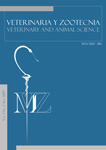Autores/as
Resumen
RESUMEN: El perfil lipídico en bioquímica clínica es una herramienta muy importante para la investigación y diagnóstico de diferentes patologías relacionadas con un metabolismo lipídico. El perfil lipídico de las muestras de 127 caninos adultos sanos (61 machos y 66 hembras) divididos en tres grupos de edad (1 a 3 años; 3,1 a 7 años y mayores de 7,1 años) fue determinado utilizando el método de Friedewald, buscando establecer valores de referencia para algunos lípidos sanguíneos. No se encontró diferencia estadísticamente significativa entre machos y hembras. Sin embargo, se observan claras diferencias en los valores obtenidos en el presente estudio al compararlo con otros; además, en la literatura consultada se encuentran diferencias entre los valores obtenidos por el método usado por nosotros, el cual calcula los valores de colesterol VLDL y colesterol LDL mediante fórmula, y otros como el método directo.
Palabras clave
Citas
Baigent, C; Burbury, K; Wheeler, D. Premature cardiovascular disease in chronic renal ilure. Lancet, v.356, p.147-152, 2000.
Bauer, J.E. Comparative lipid and lipoprotein metabolism. Veterinary Clinical Pathology, v.25, p.49-56, 1996.
Bergeman, E.N.; Havel, R.J.; Wolfe, B.M. Quantitative studies of the metabolism of chylomicron, triglycerides and cholesterol by liver and extrahepatic tissues of sheep and dogs. The Journal of Clinical Investigation, v.50, p.1831-1839, 1971.
Carvalho, C.M.F.; Batista, J.A. Taxa de colesterol no soro sanguineo de caes clinicamente sadios. Arquivos da Escola Superior de Veterinária de Belo Horizonte, v.11, p.113-115, 1958.
Cattran, D.C.; Steiner, G.; Wilson, D.R.; Fenton, S.S.A. Defective triglyceride removal in lipidemia associated with peritoneal dialysis and hemodialysis. Annals of Internal Medicine, v.85, p.29-33, 1976. Coles, E.H. Veterinary Clinical Pathology. 4th ed.
Philadelphia: Saunders, 1989. Coppo, J.A. Fisiología Comparada del Medio Inter- no. Buenos Aires: Ed. Dunken, 2001.
Coppo, N.B; Coppo, J.A.; Lazarte, M.A. Intervalos de confianza para colesterol ligado a lipoproteínas de alta y baja densidad en suero de bovinos, equinos, porcinos y caninos. Revista Veterinaria, n.14, p.1-10, 2003.
Downs, L.; Bolton, C.H.; Crispin, S. Plasma lipopro- tein lipids in five different breeds of dogs. Research in Veterinary Science, v.54, p.63-67, 1993.
Duarte, L.Z. y Col. Estudio comparativo del perfil lipídico y glicemia en caninos obesos de las razas Poodle y Labrador. Revista Colombiana de Ciencias Pecuarias, n.18, p.43-65, 2005.
Florio, R.; Lescure, F.; Guelfi, J.F. Reseignements fournis par l´examen biochimique du sang chez les carnivores et les équides domestiques. Reveu Méditerraneen Vétérinaire, v.122, p.95-119, 1971.
Forstner, V. Laboratory Testing in Veterinary Medi- cine. 3th ed. Publ. Boehringer Lab, Mannheim, 1985.
Friedewald, W.T.; Levy, R.I.; Fredrickson, D.S. Estimationof the concentrationof low-density lipoproteincholesterol in plasma,without useof the preparativeultracentrifuge Clinical Chemistry, n.18, p.499-502, 1972.
Gleeson, J.; Hejazi, J.; Kwong, L.; Chang, I.F.; LE, T.; Alberts, A.W.; Wilson, D.E. Plasma apolipoproptein E, high density lipoprotein 1(HDL1) and urinary mevalonate excretion in pancreatectomized diabetic dogs: effects of insulin and lovastatin. Atherosclerosis, v.84, p.1- 12, 1990.
Groslambert, P.; Foulon, T.; Groulade, J.; Groulade, P. Lipid and lipoproteins in the normal dog in relation to age and sex. Bulletin de l’Academie Veterinaire de France, v.58, p.473-484, 1985.
Hattori, Y.; Suzuki, M.; Tsushima, M. et al. Development of approximate formula for LDL- Chol, LDL-apo B and LDL-Chol/LDL-apo B as indices of hyperapobetalipoproteinemia and small dense LDL. Atherosclerosis, v.138, p.289-299, 1998.
JJohnson, R.K. Canine Hyperlipidemia. In: Internal medicine in Small Animals. Philadelphia: Saunder Philadelphia, 1994. p.214.
Kaneko JJ. Clinical Biochemistry of Domestic Ani- mals. 4th ed. San Diego: Academic Press, 1989.
McTigue, K.; Larson, J.C.; Valoski, A.; Burke, G.; Kotchen, J.; Lewis, C.E.; Stefanick, M.L.; Van Horn, L.; Kuller, L. Mortality and cardiac and vascular outcomes in extremely obese women. Journal Of the American Medical Association, v.296, p.79-86, 2006.
Nauck, M.; Warnick, G.R.; Rifai, N. Methods for measurement of LDL-Cholesterol: a critical assessment of direct measurement by homogeneous assays versus calculation. Clinical Chemistry, v.48, p.236-254, 2002.
NCEP. Expert Panel on Detection, Evaluation, and Treatment of High Blood Cholesterol in Adults. Executive summary of the third report of the National Cholesterol Education Program (NCEP) expert panel on detection, evaluation, and treatment of high blood cholesterol in adults (Adult Treatment Panel III). Journal of the American Medical Association, v.285, p.2486- 97, 2001.
Osorio, J.H. Total cholesterol and HDL-cholesterol in aging dogs. Biosalud, n.5, p.19-24, 2006.
Osorio, J.H.; Giraldo, C.E. Perfil lipídico en caninos adultos obesos versus perfil lipídico en caninos adultos normales. Revista Veterinaria y Zootecnia, n.11, p.22-27, 1999.
Planella, T.; Cortés, M.; Martínez-Bru, C.; González- Sastre, F.; Ordoñez-Llanos, J. Calculation of LDL-Cholesterol by using apolipoprotein B for classification of nonchylomicronemic dyslipemia. Clinical Chemistry, v.43, p.808-15, 1997.
Rajan, A.; Mohiyudden, S. Blood serum cholesterol level in hypothyroidism in dogs. Kerala Journal of Veterinary Science, n.4, p.117-119, 1973.
Rodríguez, M.S.; Castillo, V.A.; Lalia, J.C.; Feijoo, S.C.; Meschiatti, C.T.; Ortemberg, L.R.; Aisemberg, L.; Zago, V.; López, G. Estudio de las dislipemias del perro en Buenos Aires, Argentina. Medicina Veterinaria, v.83, p.36-39, 2002.
Sodikoff, C.H. Laboratory Pro£les of Small Animal Diseases. 2th ed. Baltimore: Mosby, 1996.
Warnick, G.R.; Knopp, R.H.; Fitzpatrick, V.; Branson, L. Estimating lowdensity lipoprotein cholesterol by the Friedewald equation is adequate for classifying patients on the basis of nationally recommended cutpoints. Clinical Chemistry, n.36, p.15-19, 1990.
Watson, T.D.; Butterwick, R.F.; McConnell, M.; Markwell, P.J. Development of methods for analyzing plasma lipoprotein concentrations and associated enzyme activities and their use to measure the effects off pregnancy and lactation in cats. American Journal of Veterinary Research, v.56, p.289-296, 1995.

 PDF
PDF
 FLIP
FLIP










